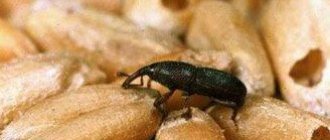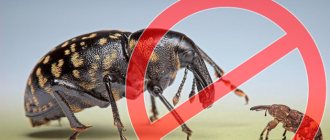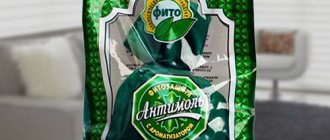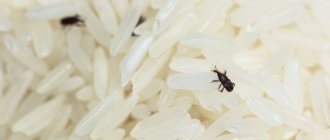Why do rice get bugs?
Read also: What to do if my mother hits me
Let's say right away - bugs in cereals are not a sign of unsanitary conditions in the kitchen. Even in sterile conditions they start up with enviable regularity.
If manufacturers do not comply with sanitary standards, if they do not process cereals in accordance with established rules, it will not be possible to avoid the appearance of uninvited guests.
But, even if the cereal is of the highest quality and absolutely clean, beetles can still appear in it. They come from neighboring products (tea, coffee, pasta, dried fruits, etc.) and multiply very quickly.
Why do rice get bugs?
Let's say right away - bugs in cereals are not a sign of unsanitary conditions in the kitchen. Even in sterile conditions they start up with enviable regularity.
If manufacturers do not comply with sanitary standards, if they do not process cereals in accordance with established rules, it will not be possible to avoid the appearance of uninvited guests.
But, even if the cereal is of the highest quality and absolutely clean, beetles can still appear in it. They come from neighboring products (tea, coffee, pasta, dried fruits, etc.) and multiply very quickly.
Chemical methods and store-bought products
It happens that it is impossible to get rid of bugs in cereals using folk remedies. In this case, store-bought products will come to the rescue. They help even with severe lesions.
Before using chemical solutions, you need to know the safety rules:
- Processing should be carried out using personal protective equipment. This is a mask and gloves. They will help protect the skin and mucous membranes of the eyes and respiratory system from the harmful effects of chemicals.
- Disinfection is carried out in the absence of children and pets.
- The room must be ventilated after treatment.
- After 2-3 days, repeat the procedure to consolidate the result.
Products containing chlorine will help destroy parasites that infect cereals. This is “Whiteness” or “Domestos”. With their help, all surfaces in the kitchen are wiped, and after 1-2 hours they are ventilated.
Also effective drugs against bugs in cereals are:
- "Pyrethrum."
Sold in powder form. It is poured on the shelves where cereals are stored. After a couple of days, the parasites will completely disappear. The drug is safe for children and animals. - "Anti-bug."
The product is intended for treating wooden surfaces. Thanks to its properties, the drug will destroy insects and prevent their appearance in the future. It must be used with caution, as if it comes into contact with mucous membranes or skin, it can cause severe irritation or chemical burns. - "Avalanche Fire Protection".
Used if you have a bread grinder or flour eater. Before use, you must wear a respirator to protect the mucous membranes and organs of the respiratory system. The fumes from the product are dangerous to the body. - "Rogneda".
The preparations of this company are known for their properties to quickly and effectively destroy not only bugs in cereals, but also other insects, for example, cockroaches, ants, flies.
All food and utensils should be removed, and spoiled cereals should be thrown away. The kitchen or pantry should be ventilated only after 1-2 hours so that the drug has time to take effect.
Thermal fighting - what effect does it give?
Disposal
The main method of combating the bug is the disposal of affected supplies. Of course, it’s a great pity for spoiled flour or cereal, but if there are insects in it, it means that a couple more days will pass and they will crawl throughout the house. Therefore, it is urgently necessary to tie the bag tightly and put it in another bag and take it to the trash.
After disposal, it is necessary to wash kitchen shelves and cereal storage containers (if any) with bleach, soda or vinegar. After treatment, be sure to rinse the surfaces with water.
All types of insects die at temperatures above 50 degrees. This can be either boiling water or steam treatment. This method is good for eliminating bug nests in baseboards and crevices that cannot be reached with chemicals and sanitation.
To remove bugs directly from cereals, you can fry them in the oven at a temperature of about 50-70 degrees for 20 minutes. Or put it in the freezer for several hours. Insects die at temperatures below 15 degrees.
When the larvae and adults are destroyed, it is necessary to thoroughly rinse the grains (beans, beans, nuts) with water and wait for the pests to surface. Then, drain the water and rinse the product again so that there are no larvae left in it. After heat treatment, it is better to sift flour and small grains through a sieve 2-3 times.
Chemicals
On open kitchen surfaces, it is better to use special chemicals, which are sold in abundance in hardware stores. Just don’t buy simple remedies for cockroaches and ants to fight the bug. In this case, specialized products are needed, for example, “Antizhuk” or “Karbofos”.
“Anti-bug” helps in the fight against any bug, be it cereal or wood, that damages windows and furniture. The drug is quite effective, but be sure to read the instructions before use, as it is toxic.
Is it possible to eat this cereal?
If you find cereal that has bugs in it, don’t even think about whether it can be used, but throw it away immediately. Contaminated products contain the remains of chitinous shells, excrement, and various forms of insect development. Bacteria and fungi settle in such cereals and find an environment for development.
We suggest you read: Stretched viscose dress, what to do
The remains of shells covered with bristles are not digested in the digestive tract of humans and can cause irritation and inflammation of the stomach. Guanine and scleroproteins that are part of tick waste are not absorbed by any organism. In grain affected by pests, uric acid is formed in large quantities, which can cause a number of diseases in humans.
If there are bugs in rice, buckwheat, oatmeal or any other cereal, do not use it. Damage to the body is not detected immediately after eating spoiled cereals. The process of undermining is hidden, cumulative and gradual. As a result of such nutrition, amino acid metabolism in the body is disrupted, the number of red blood cells and hemoglobin in the blood decreases, which leads to lethargy, weakness, and sometimes more serious consequences. Therefore, if there are bugs in the cereal, then it is better to get rid of it than to have health problems. The same applies to flour.
Theoretically, flour containing bugs can be used, but is it worth it? No matter how you sift it, there will still be excrement in it. For example, flour damaged by the Moorish booger darkens, acquires an unpleasant odor and becomes unsuitable for use in cooking. If you make dough from such flour, it will not rise well and the bread will turn out low and soggy.
People are so accustomed to cereals lying on store shelves that they buy without thinking, just by looking at the price or seeing a familiar manufacturer. However, so that you don’t have to think later about whether you can eat cereal if there are bugs in it, you should be responsible when choosing such an important product.
Knowing some subtleties you will not waste time and money in vain:
- When purchasing, be sure to look at the manufacturing date. The longer the cereal sits, the more likely it is that it will begin to deteriorate or that moths will appear in it.
- The product should not have any foreign odors, otherwise it is spoiled and by purchasing it you will not be protected from the appearance of black bugs.
- High-quality cereals contain no impurities or husks. Crushed particles in whole grains indicate improper production and the presence of pests that have already begun to “gnaw” the product.
- The cereal should not have lumps. Their presence indicates that the product was stored near water, and it gained moisture or grain moths appeared in it.
After purchase, cereals should be stored in dry containers without foreign odors with tight lids that do not allow moisture and pests to pass through. Having discovered occupants in one of the cereals, you need to check all supplies, wash, dry and ventilate kitchen cabinets.
Since you will not be able to completely get rid of bugs in flour and cereals, without a doubt, throw away the spoiled product. This is the only thing you can do in this situation if you are responsible about your health.
Black bugs and other insects in flour and cereals are a common problem. When they appear, they quickly infest everything, and a few days of delay can lead to a long time to remove the pests. They not only spoil food, but can also cause poisoning and allergic reactions.
How do they reproduce?
Rice weevils are prolific insects. Under favorable conditions, 2-6 new generations of beetles appear in 12 months, because development takes 1-3 months.
To lay an egg, the female gnaws a hole in the grain and then seals it with the secreted substance. After 1-1.5 weeks, a larva emerges from the egg and gnaws out the passages inside. Sometimes eggs are laid on both sides of the grain, then 2 legless, white-yellow larvae live inside.
For 3-4 weeks the larva feeds on the internal contents of the grain, eating half of it, then pupates. During this time, the cereal becomes lighter by 30-70%. After 1-1.5 weeks, an adult beetle emerges from the cocoon, whose life lasts up to 6 months.
Preventive measures: how to prevent infection?
Simple precautions will help you avoid such an unpleasant problem as kitchen pests.
- To prevent bugs from infesting flour and cereals, they must be stored at medium humidity in a well-ventilated area;
- You need to make sure that there are no raw or undried foods (dried fruits, vegetables, wet cereals) in the kitchen cabinets. If there are any, then the mucoed will definitely settle in them;
- It is mandatory to regularly inspect products and shelves. Make sure that cereals do not sit for a long time; long-term storage is the main cause of insects.
- Keep cloves, bay leaves and matches in your kitchen cupboard to repel pests.
- Store cereals and grains in plastic or glass containers with an airtight lid.
- If you notice the first signs of spoilage of food, immediately throw it away or rinse or sift through a sieve.
- Carry out general cleaning at least once a month using disinfectants.
Before we move on to discussing the question of how to get rid of cereal bugs in the kitchen, let's take a closer look at the “opponents”. Insects, whose vital needs so unfortunately coincided with our interests, belong to one of the following varieties:
- flour beetles;
- bread grinders;
- food moth;
- red mucoeds.
Naturally, the longer the little black bugs in the kitchen go unnoticed, the more food will be destroyed. Khrushchaki reproduce very quickly, laying their eggs in a variety of places. Newborn larvae immediately begin to invade nearby “deposits”. We will tell you below how to deal with bugs in cereals and flour.
Other types of harmful insects are much less common. The mole is easy to spot. Its adults can reach 10 cm in length. Outwardly, these cereal beetles resemble silver butterflies. Such “guests” enter the apartment through ventilation and windows. The object of their attention is products stored in the public domain.
Bread grinders and flour eaters prefer to settle in industrial enterprises. When it comes to these insects, the problem of how to get rid of insects in cereals concerns more the personnel of the above organizations. However, unfortunately, ordinary citizens also have to deal with them. Grinders are small flying white bugs in the kitchen that can measure up to 3mm.
Their target is usually bread and flour products: biscuits, cookies, etc. In this regard, they pose the greatest danger to bakeries and flour mills. Grinders enter residential buildings through bags of food or animal feed. In addition to bakery products, these food bugs happily consume coffee, tea, dry plants, animal feed and even book bindings. So if they happen to be your guest, it's not just your kitchen cabinets that may need a major cleaning.
How to get rid of flour eater is also a relevant question mainly for owners of food enterprises. These miniature red insects can only feed on rotten grain or flour. If the humidity of the product is below 15%, it is not in danger. How to get rid of mucoed in an apartment? Very simple. You just need to throw away substandard food in a timely manner.
To prevent insects in cereals from complicating your life by requiring a number of operations to destroy them, you can follow simple recommendations regarding the prevention of their appearance. These include:
- Warm up the purchased cereals in the oven at low temperature for half an hour.
- Freezing bulk products in the freezer for 24 hours (use dry, ventilated packaging).
- Dried fruits are treated with boiling water, followed by washing and storing exclusively in the refrigerator.
- Thorough inspection of purchased products (including vacuum packaging) with disposal of cereals and flour with signs of contamination.
Bulk materials should be stored in perforated polyethylene or closed glass containers. As an alternative, metal boxes and ecological bags made of natural linen are suitable.
One of the reasons why bugs appear in flour and cereals is failure to comply with the shelf life of products. To avoid creating conditions favorable for pests, it is worth buying cereals and other bulk products, as well as dried fruits, coffee and tea with a minimum supply.
It is believed that rice, semolina, flour and buckwheat can be stored for no more than six months; oatmeal and millet can be stored for no more than 4 months due to their high fat content.
The record holder for shelf life is polished rice. Many varieties become even better after several years of storage, acquiring additional taste.
If you still cannot avoid contamination of food in the kitchen, you can get rid of bugs in cereals, flour and spices in several ways.
What are these pests and how dangerous are they?
Let's get to know pests better and find out which bugs most often “settle” in dry cereals.
Small flour beetles
Reddish-brown long bugs (3-3.5 mm) with wings, short antennae and rounded sides. Pests like buckwheat, semolina, flour, dried fruits, and millet. Flour bugs need to be dealt with immediately: eating foods with insects can cause stomach disorders, poisoning, and allergic reactions.
Small beetles reproduce at an astonishing rate: pests produce up to four generations of offspring per year. Mealworms are the larvae of this pest.
Surinamese mucoeds
Red beetles with long mustaches, whose body has a saw-tooth shape and is lined with short silky hairs. The length of insects is 1.5-2.5 mm. Typically, mealworms find refuge in rotten flour, corn grits, and loose pet food. Bulk products with a moisture content of less than 15-17% are not afraid of such pests.
One of the characteristic signs of “infestation” with red pests is a sieve for sifting flour chewed to holes. Con, insects increase the humidity of the cereals, littering the reserves with excrement and shells of larvae.
Bread grinders
Brown or red-brown bugs are cylindrical in shape, 1.8-3.7 mm long, the body of which is covered with hairs. Pests are unpretentious when it comes to food. Cereals and grains, tea and coffee, dried herbs, crackers, cookies, pet food, nuts and dried fruits - voracious insects are not averse to eating all of this.
The waste products of grinders are hazardous to health. Even if you manage to remove the insects from their grains, eating the spoiled product is strictly contraindicated.
If the number of insects is small, you may not even notice their presence - they do not crawl out. But if the density of their “population” is high, waste products and dead insects are found in herbariums, book bindings, even on walls and window sills.
Rice weevils (elephants)
Dark brown or almost black beetles with underdeveloped wings, body length - up to 4 mm. Most often, the pest settles in pasta, rice, barley grains, millet and rye, and flour. The waste products of pests and larvae are toxic, therefore, if even one beetle is found in the products, they can no longer be eaten.
food moth
A gray moth, the body length can reach 1 cm. The moth part is found in dried herbs, cereals, sugar and flour. Food moths, feeding on food supplies, contaminate them with excrement and remains of shells.
When asked whether bugs in cereals are dangerous for humans, experts answer in the affirmative, so if insects are detected, you must immediately begin fighting them.
How to get rid of bugs in the kitchen: control methods
If there are bugs in your kitchen, they need to be removed immediately.
1. If the degree of damage to food products is insignificant, then there is no need to rush to throw them away. In this case, the cereal should be sifted out using a sieve and heated in an oven at a temperature of 110°C.
2. Barn pests can also be destroyed by placing the cereal in which the insects have settled in the freezer for a day.
3. If you find bugs and larvae in beans or peas, you can get rid of them as follows. Pour salt water over the beans and leave for a few minutes. When the larvae and the insects themselves float to the surface, the water must be drained and the clean legumes dried.
4. It is better to throw away products that are severely damaged by pests, since eating them can cause irreparable harm to your health.
5. To forget about bugs in the table or kitchen cabinet, first of all you need to get rid of insect larvae and eggs. All cabinets should be emptied of food and wiped with a vinegar solution. For one liter of water, it is enough to take one tablespoon of liquid. The cracks of the drawers need to be filled with boiling water. Jars in which flour and cereals are stored should be thoroughly washed with laundry soap and then doused with hot water. If fabric bags were used to store food, then a saline solution is suitable for processing them. There is no need to rinse, then the bugs will not lay eggs in them again.
Causes of flour bugs
It's easy to get bugs. Both the owner and the manufacturer of the product can provoke their appearance. This may be a violation of GOST technologies or storage conditions and incorrect “neighborhood” in the warehouse, a violation of the tightness of the packaging, the expiration of the cereal, or ingress from the outside.
Through the fault of the housewife, infection can occur at home:
- Improper storage of cereals. Increased dampness in the house and storage in unsealed conditions create conditions for the appearance of insects. Cereals should not be stored in a warm place.
- Storage of expired products. Cereals that have been stored for a long time have a much higher chance of becoming food for pests. You should always check the expiration date and throw away bad cereals promptly.
- Incorrect packaging. When storing in bags, they should be closed, avoiding open areas. Ideal containers are glass or plastic containers with lids.
Treats from relatives and neighbors can also cause infection. Especially if you take from your hands products that are loved by pests. These are not necessarily cereals; sometimes insects can enter the house with other household items.
Some places are favorite among harmful insects. Especially because they are the hardest to find there:
- Food products and their remains in bags, unsealed containers and other containers. Especially tea leaves, seasonings, dried fruits.
- In a kitchen set, they become the sole owners of the shelves and are able to gnaw holes in them.
- Other furniture.
Risk areas include the cooking area, where waste particles are regularly left behind.
Attention! They can get into the house in a thousand ways, from barley borrowed by a neighbor to purchased furniture and equipment.
In some cases, bugs can settle in places that are “inedible” for them. Therefore, when buying products secondhand or borrowing products from someone, it is better to be vigilant. Goods purchased by weight or at fairs are also dangerous.
How they live
Rice weevils are heat-loving insects; they live and reproduce at temperatures of 27-30 degrees, but do not die for 4 days if the frost drops to 5 degrees. In addition, they prefer air humidity of 70-90%, and grains - 10-17%.
These are marathon runners – agile and capable of covering long distances. They hide in a shaded place, and if the weevil is touched, it pretends to be dead, but not for long - it lies down and runs away.
“Rice farmers,” like marathon runners, have energetic breathing, so when they are poisoned by gas, they die faster than barn bugs.
Insects that overwinter in fields look for underground tunnels, burrows, or piles of grain for the winter. They live in one place until the food runs out, then they fly away or go to another nourishing place.
Why can bugs appear in flour or cereals?
Beetles appear in cereals or flour, as well as in nuts, dried fruits, beans, peas and even tea, not because of the untidiness of the housewife or uncleanliness in the kitchen cabinet, if they were not there before. Bugs appear from outside.
Interesting: How to dry bay leaves correctly
From a pack bought in a store, from cereal taken from a neighbor or relatives, from dried fruits brought as a treat that were already infested with bugs.
This photo shows that the bugs that are in the cereal are not always easy to see!
Why do cereals get bugs? The reason is unscrupulous checks at enterprises when packing cereals and flour, and poor initial processing of grain. Grain must be processed in a special way before becoming cereal in order to exclude the possibility of the presence of living organisms and their larvae in it.
Another reason is the poor quality of work of the control bodies monitoring the quality of products. Any low-quality, contaminated batch of cereal or flour must be rejected and not allowed for sale.
Otherwise, bugs appear in flour or cereals, and people have to think about how to get rid of them.
Prevention
To prevent insects from appearing in bulk products, you need to follow a number of simple rules:
- Immediately after purchase, store-bought cereals are calcined in the oven for 10-15 minutes, and then scattered into airtight containers with a tight-fitting lid.
- When deciding what to do to prevent pests, you should avoid buying large volumes of products, as they are more difficult to protect.
- Knowing why bugs often appear in cereals, you can prevent its infection by placing a clove of garlic in a container.
- It is better to store food in the refrigerator: dried fruits, cereals, nuts.
- Bay leaves can be used instead of garlic.
In addition to the methods discussed, it is recommended to periodically treat the internal surfaces of cabinets using a vinegar solution. For the same purpose, Pyrethrum powder is laid out on the shelves.
Related posts:
General cleaning as a method of pest control
Pests can also be removed by thoroughly cleaning their habitat. But subject to the obligatory condition of disposal of affected products.
What do we have to do:
- Empty the cabinet or shelf of its contents. Clean everything inside with a soapy vinegar solution. Pay special attention to food residues that often spill out in storage areas.
- Pour boiling water over all containers.
- Wash fabric bags in salt water.
- For adult individuals, it is better to use special traps.
Plants with a pungent odor also show good results in the fight against insects. These include mint, lavender, lemon balm and others. Soaking cloth strips in extracts will help prevent a new insect infestation. The main thing is not to forget to update your feeds.










